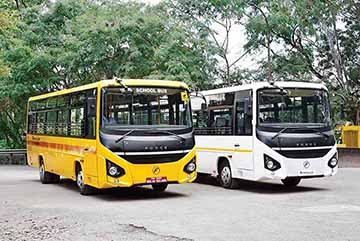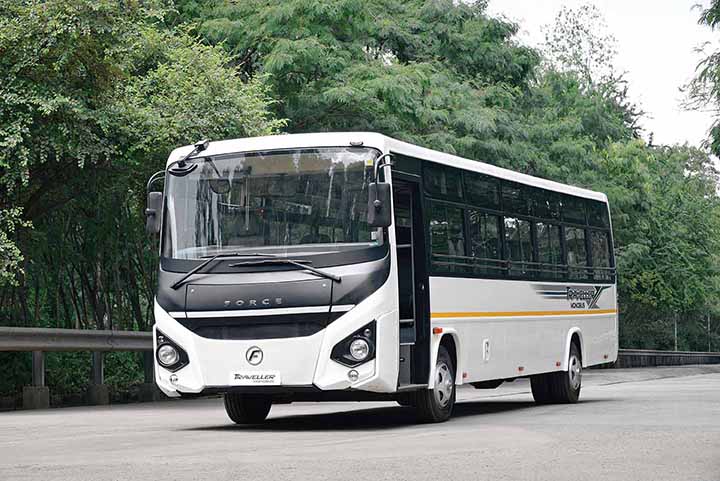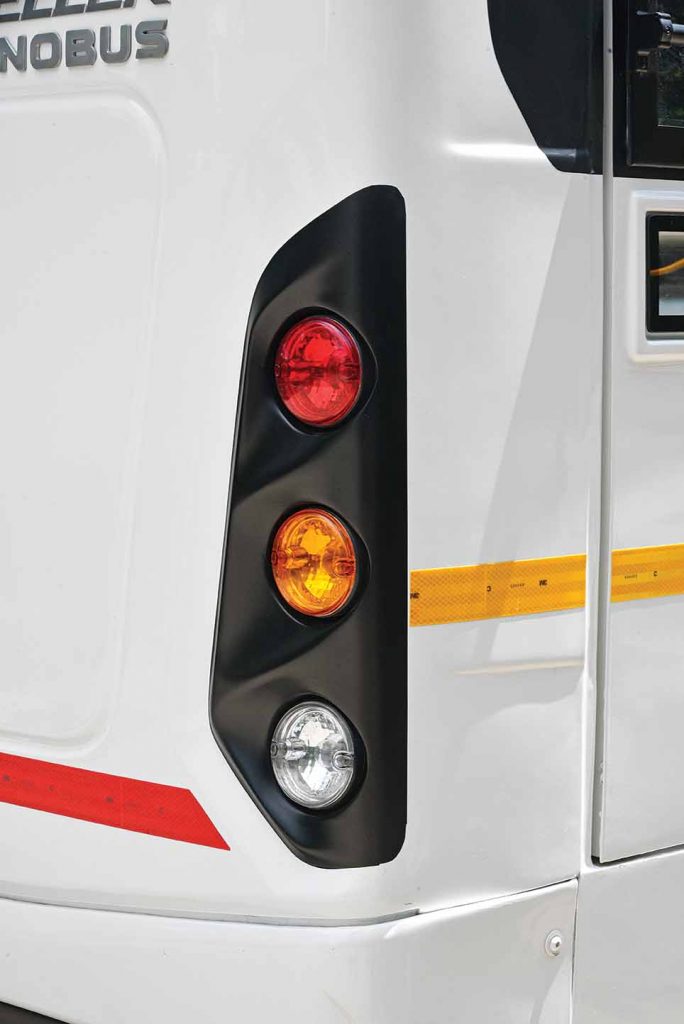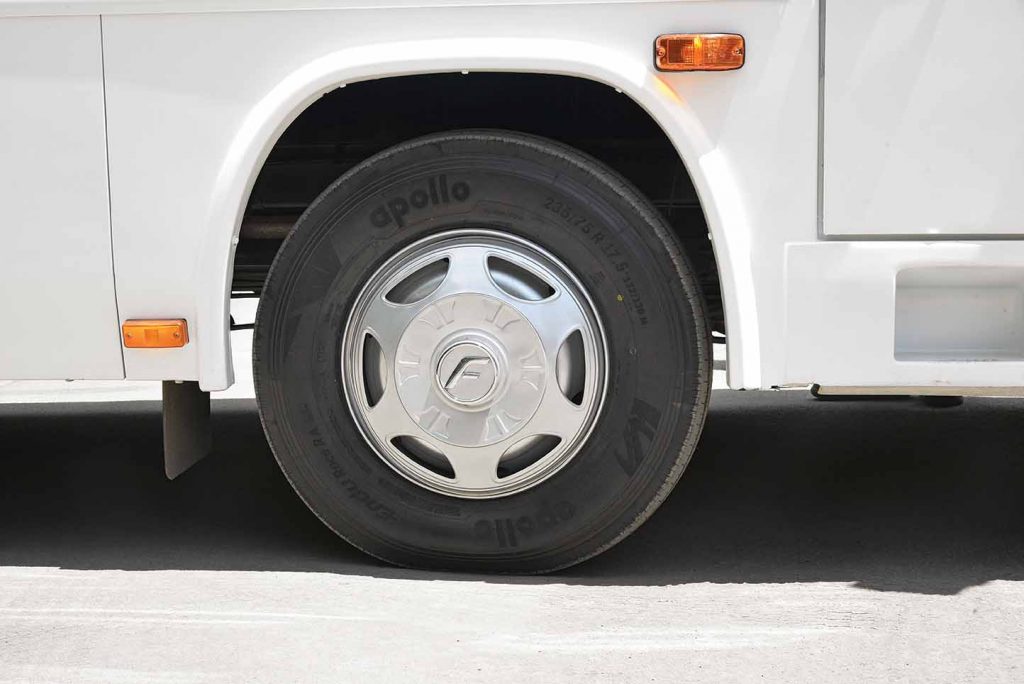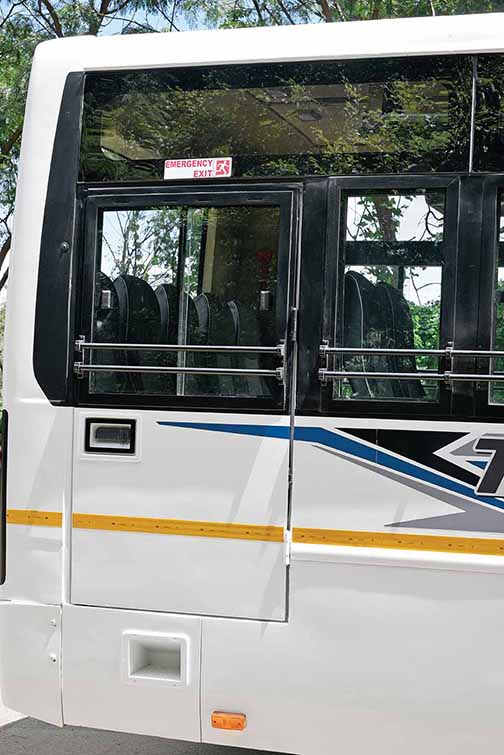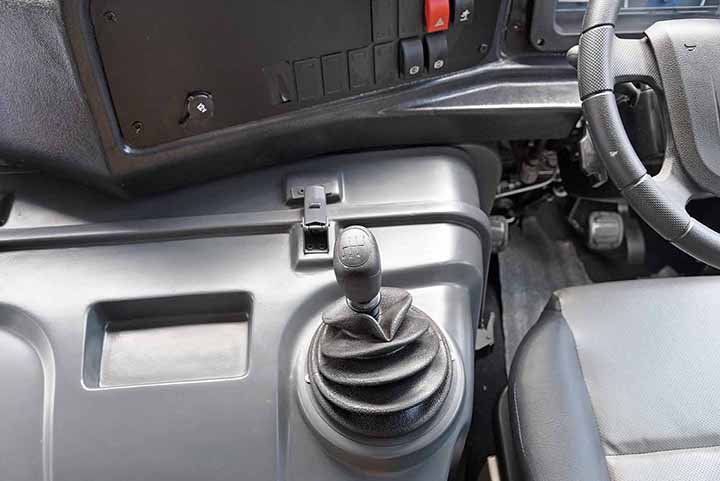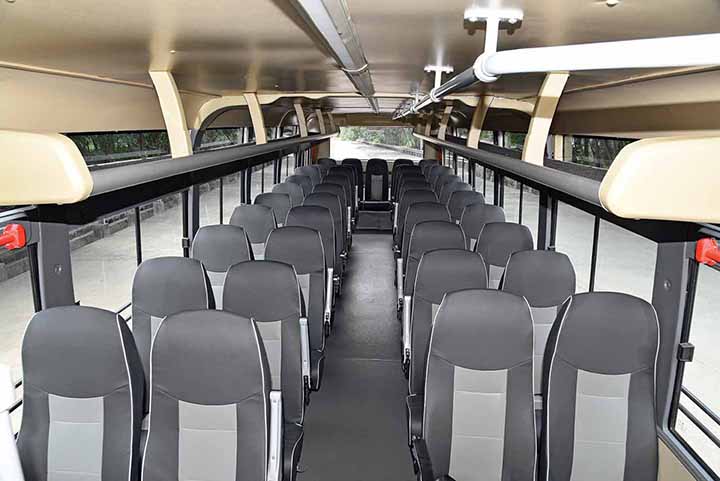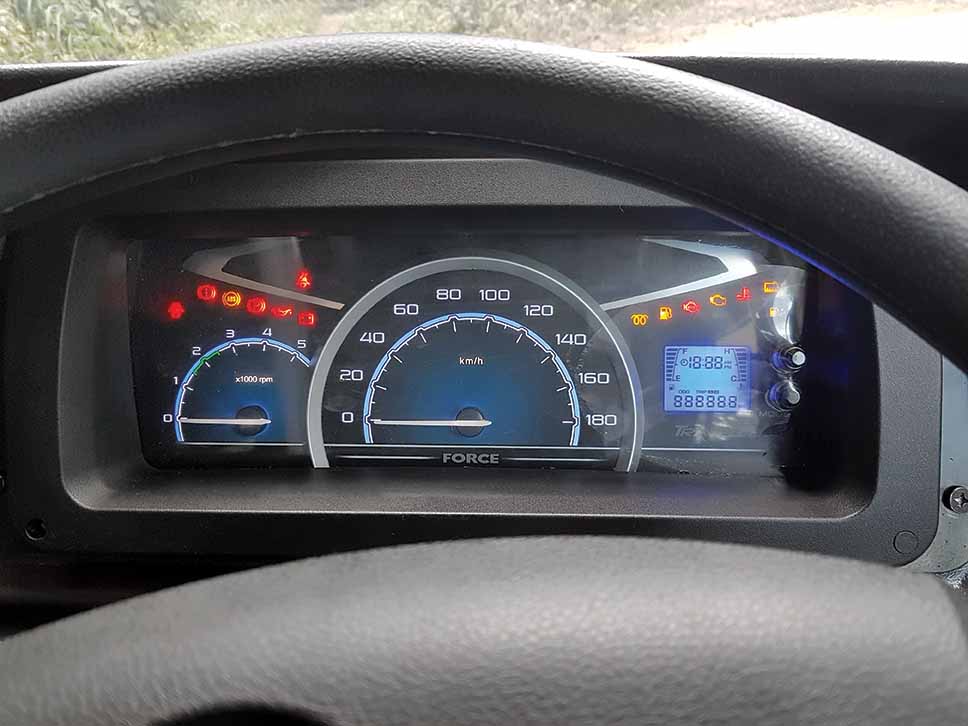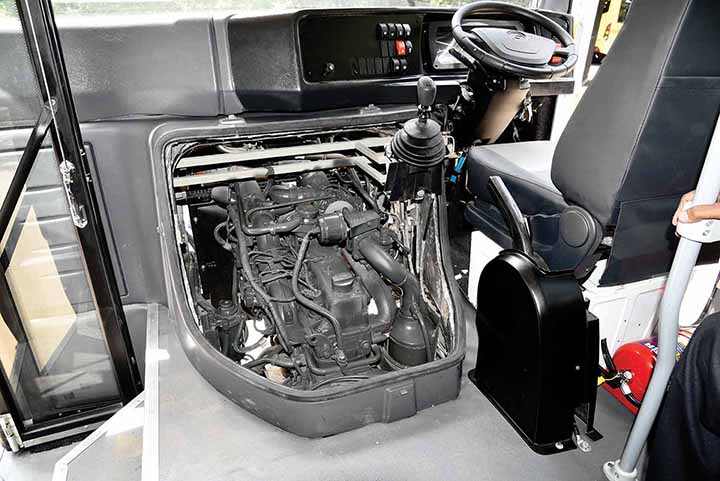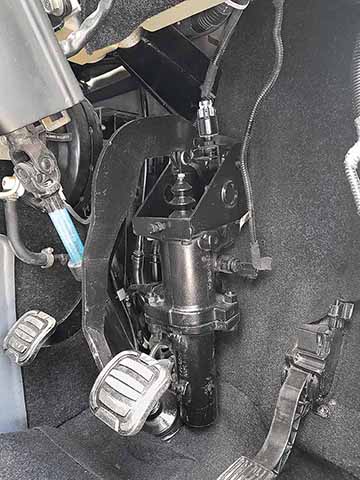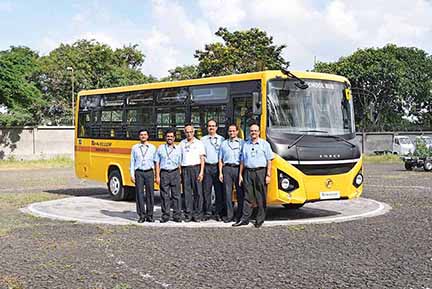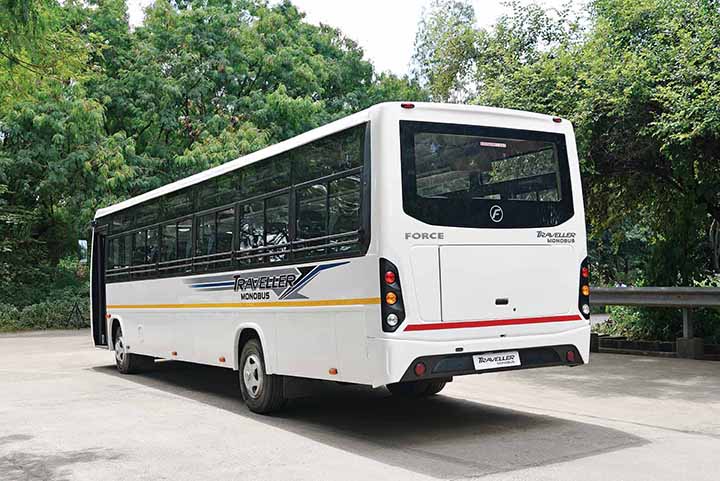The Traveller Monobus from Force Motors reflects a significant change.
Story: Bhushan Mhapralkar
Photos: Mahesh Reddy
Unveiled at Busworld India 2018, the Traveller Monobus marked the arrival of yet another important product from Force Motors in the commercial passenger vehicle space. Found in two versions – one measuring 8.5 m in length, and the other measuring 10 m in length, the Monobus, like the T1 and T2 Traveller is a monocoque body construction. Aiming at applications like the staff, tourist, school, and executive travel, the Monobus stands out for its monocoque body construction. Influenced by the manner in which aeroplanes are built by joining different parts, termed as bulkheads, the body structure of the Monobus is built by welding precisely pressed steel panels to an accurate structure. Adhering to strict light-weighting targets, the vehicle leverages the experience Force Motors has come to acquire with the successful manufacture and sale of T1 and T2 Traveller. Sold for the last 20 years, the T1 and T2 Traveller feature monocoque body construction. The bodies of both the vehicles (T1 and T2) are constructed by welding precisely pressed steel panels. Riding on the ambition of the company to tap yet another segment in the commercial passenger vehicle space, the Monobus builds on the resounding success of the T1 and T2 Traveller. Taking little more than two years to develop, and referred internally as the T3 Traveller, the smaller 33-seat Monobus variant was first conceptualised as a step up from the 26-seater T2 Traveller. The 41-seat variant soon followed.
Engineered to exhibit superior build quality and achieve significant weight saving (the Monobus is 800 kg lighter than comparable models), the Monobus (with no chassis to deal with), according to Dr. Abhay Firodia, Chairman, Force Motors, was conceptualised, designed, tooled and produced using robots as part of a precise manufacturing process. Looking contemporary, the bus will form the basis for the electric vehicles the company will design and develop. Hinting at a different stance when compared to the T1 and T2 Traveller in terms of the application of technology, and the vision for the future, the Monobus is set to play out a platform that is versatile, and addresses the demand for lightweight construction and an ability to package the battery and associated components as far as an electric vehicle is concerned. A full forward control design with a large windshield and distinct snout, the front fascia of the Monobus is finished in a two-tone colour. The upper half has painted a shade of matte black. It covers the small grille and makes it hard to notice. The headlamps are placed in plastic nacelles, finished in a shade of black. The shape of the nacelles nicely corresponds to the bottom line of the top half, which is finished in matt black.
Two body elements on either side along the lower portion of the front fascia provide an impression of being a part of the bumper, which does not seem to exist. The contemporary looks of the bus hint at technology. Technology is what gives the Monobus an edge. Behind the grille is a 115 hp, 3.2-litre common-rail turbo-diesel engine placed longitudinally. It is mated to an all-new five-speed manual transmission with the drive going to the rear wheels. Featuring all new axles, which were designed with the necessary beam strength and an ability to operate, according to Dr. Firodia, the Monobus is equipped with parabolic leaf spring suspension and anti-roll bars at the front and rear. To ensure they did not make much operating noise, attention was paid to various components like axles, suspension, transmission, etc. In a monocoque body construction, said Dr. Firodia, it is possible to hear such noises over the noise of the body structure. A result of the efforts put in by the Force Motors’ R&D team, an in-house tool room (that made all the tools and fixtures), and a band of suppliers, the Monobus is cleverly packaged. The driver cockpit and entry (exit) door are placed ahead of the front axle, leaving much space for the passenger compartment. A challenging project in the absence of pressed panel buses in other markets, and even up to 26-seats, the vehicle utilises thousands of tools for its manufacture.
With experienced engineers in the R&D providing the necessary confidence, the development of Monobus saw the participation of many young engineers as well. Of the opinion that young engineers are quick to learn, quick to execute, efficient and willing to learn. Dr. Firodia mentioned that the Monobus saw cross functioning of various teams. He revealed that the core team was of about 10 people. “A lot of resources that went into the development of this vehicle platform were actually not related to it,” Dr. Firodia added. Pointing at the contribution of Group companies, Dr. Firodia explained that the main thrust for the Monobus came from within Force Motors. Utilising advanced manufacturing techniques (a dedicated weld shop with necessary automation has been built by Group entity Jai Hind within the Pithampur plant of Force Motors to facilitate precision welding), the Monobus, according to Dr. Firodia, offers customers the benefit of high standardisation, high standards of workmanship, and high build standards. Modern in flesh and spirit, the vehicle rides on 17.5-inch dia. wheels, and 225/75 R17.5 tubeless tyres. Sharing the press shop, CED coating line (for superior rust prevention), robotic painting line, and the final assembly line with T1 and T2 Traveller at the Pithampur plant, the Monobus is set to offer a superior option to the operator on the count of better comfort, better feel and greater safety.
An advancement in providing a solution to many applications, according to Dr. Firodia, the Monobus is set to serve the changing transportation needs in-line with the infrastructure changes and market requirements. Some unique engineering attributes that the Monobus incorporates, and which go beyond its monocoque body construction include the unibooster. It combines the ability to boost as well as actuate a traditional master cylinder. As part of a hydraulic braking system, it aids weight saving through the use of fewer components and by being highly efficient. The only bus in its category to have a hydraulic braking system (supplied by Brakes India), the Monobus features disc brakes on all four wheels. The system is ABS, EBD and EDTC (Engine Drag Torque Control) assisted. Stating that all the vehicles (even school buses) up to 16-tonnes in the US must have hydraulic brakes, Dr. Firodia expressed that such a system has inherent advantages of a better feel, and is light in weight. Backed by a 300,000 kms or three-year warranty (whichever is earlier) on the driveline, the Monobus will be made commercially available before the end of this calendar year. Offering a commanding driving position with much visibility, the Monobus features a modern dashboard. It contains an instrument panel, which has an LCD readout. Pointing at a number of electronics on board, the LCD readout also speaks about the modern IT-driven technologies like Child-Bus tracker the vehicle could be had with.
To play a platform for a slew of technologies and features (most of the IT driven) that Force Motors is developing, or has developed, the bus, said Dr. Firodia, is future ready. He informed that the Monobus will comply with BSVI norms by 2020. Expected to combine EGR and SCR, the bus currently meets BSIV norms with EGR. A brief drive revealed that it is easy to pilot. Well-engineered with attention to ergonomics, most controls are within easy reach. Almost as easy to drive as the T1 and T2 Traveller except for the bigger dimensions that need to be accounted for in the mind, the midi-bus calls for the brake pedal to be pressed thrice in an interval of 30 seconds at the start of the day’s operation after starting the engine. Doing this activates the unibooster and builds the necessary pressure in the system. The steering with good power assistance helps to move out of a tight parking slot. Extending a smooth and progressive feel, the engine feels quite refined. It also responds well to inputs. Accelerating well, the bus picks up speed. The gearshifts are smooth and make for a car-like feel. Hinting at the prowess of modern engineering, the Monobus makes a positive impression. Some engine clatter is audible inside as the revs rise, the vehicle at no point felt unrefined.
Providing a comfortable ride over less than ideal surfaces, the Monobus feels quite stable. Pushed into corners, the vehicle showed no tendency to lose composure. If the tyres seemed to squeal at times, the bus did not roll as much. Feeling agile, the Monobus profits from the lower centre of gravity. Averred Dr. Firodia, “The Monobus handles like a car. It is agile and will provide good control to the driver.” Conforming to the standards laid down by the Bus Code, the Monobus, rolling out of the assembly line in a fully-built form (Pinnacle Industries has set up a dedicated trim line for the fitting of specially developed seats, wall coverings, roof coverings, hat racks and various other interior trim parts at their Pithampur facility), is looking to profit from standardisation. Said Dr. Firodia, that standardisation of transport systems will ensure the use of standardised elements (mandated by the Bus Code). It will in-turn help the operator in terms of efficiency and lower TCO. If the wide body (width is 2400 mm) construction of the midi-bus facilitates 3×3 seating, provides full standing height, ample leg space and a wide gangway, the use of advanced technologies gives the Monobus a premium feel. “It is a premium product, and will be priced appropriately,” expressed Dr. Firodia.
Laced with advanced technologies that are in-line with how buses will evolve in the future, the Monobus, apart from elevating the engineering standards at Force Motors, is set to address the issue of operators changing CVs more often for the need to have new technologies. Arriving at a time when new regulations are coming in fast and thick, the Monobus, according to Dr. Firodia, will be appreciated as more and more progress is achieved. Of the opinion that it will take time for the industry to evolve in favour of solutions like these, Dr. Firodia averred that the new technologies the Monobus packs will provide sufficient advantage to the operator searching for an efficient, reliable and comfortable bus. If the development of lightweight seats speak about the extent to which technology has found its way into the Monobus, Force Motors, in the first year of its launch, is looking at cornering 10 per cent of the market share. It is investing in dealer training and expanding its network.
——————————————–
To watch the exclusive interview or read the article on our website scan the QR Code given in the Editor’s note.
Dr. Abhay Firodia, Chairman, Force Motors
Q. How did you come to think of, and execute the Traveller Monobus?
A. We have been making monocoque buses in the form of the Traveller for the last 20 years. Marking a transition from chassis-based Matador, the Traveller with its monocoque construction made for a dramatic change in our engineering approach. The entire vehicle is made of precisely pressed body panels that are welded together. The production lines are highly automated for the purpose of matching and quality control. Robots ensure the accuracy of weld and quality. The success of Traveller convinced of a monocoque approach for the future. We, therefore, built a larger Traveller, the T2. It has the family look of the T1 Traveller. A large part of the Traveller is newly tooled up. Over 80 per cent is new and was made in-house. We could conceptualize, design, tool and produce the T2 Traveller using robots and a precise manufacturing process. The T2 Traveller offers to seat for up to 26 people. On the success of the T1 Traveller and T2 Traveller, we decided to build an even bigger monocoque bus. It would help us to grow further. A chassis-based design would not have been as technologically advanced. Accurately made, a monocoque bus would provide the advantage of better build quality and significant weight saving. Lugging 800 kgs less all the time would amount to 2.4 lakh-tonne less weight for 300,000 kms; enough to achieve phenomenal fuel savings over the lifetime apart from a much better carbon footprint. Utilising advanced manufacturing techniques, it would consume less material. We treat the monocoque vehicles we make to an advanced CED painting process for superior rust prevention. This is on par with the process that a car follows. The robotic painting line provides a high quality of paint. Rolling out of the assembly line in a fully-built condition, irrespective of the application, the customer benefits from a design that is highly standardized, has high workmanship and high standards of a build. Our ability to well-engineer the whole manufacturing process and achieve high accuracy benefits the customer. The vehicle can enter business immediately. We looked around after deciding to grow to 33- and 41-seats, and were surprised that there were no pressed panel buses even to the size of 26-seats. Undaunted, we took up the challenge to build a 33-seater monocoque bus. There would be another 41-seater version. With the challenge of ensuring accuracy, strength and weight saving, we created a completely new concept over the T1 and the T2 for the Traveller Monobus. Called internally as T3, we looked at an aeroplane to build the basic structure. We looked at how an aeroplane is built in pieces and accurately joined together. The important bits are called as bulkheads, and help the plane to achieve the necessary strength. We conceptualized a highly accurate structure to which the panels are welded. Pressed panels are precisely welded using robots and result in a highly accurate structure that is also lightweight. We created patentable designs with a focus on weight saving, on achieving a design that is light yet mass producible. In Europe, large 50 or 60-seat buses are built in what is called as a self-supporting structure. Using ERW tubes, these buses suffer from weight penalty. Rather than go for ERW tubes, we decided to use pressed panels. The process of development took a little over two years. The outcome, the Monobus, is well-engineered. Made in an advanced engineering environment and serving various applications like the staff, school, executive travel, tourist, etc., the Monobus is light in weight, highly comfortable and less noisy. Offering good ride comfort, it marks the next generation vehicle for the segment. The monocoque nature of the bus will also help us to achieve electrification.
Q. How significant is the Monobus for your electrification strategy?
A. When electric vehicles come in (our R&D has a new electrification vertical), the lightweight build of the Monobus will offer a significant advantage. It will enable packaging of a bigger battery to achieve a higher range. It will also help to achieve better performance and higher grade-ability. A saving of 800 kg amounts to huge weight savings. Future-ready, the vehicle will seek growth from large-scale employment in the service sector and greater use of school buses to ferry children. The market for T1, T2 and T3 will increase we are certain. Growing cities will increase commuting needs. We are aiming at specialised transportation needs thus. They will be in demand despite the coming up of metros, monorails and BRT systems. We are developing the right technical solutions, and have a highly capable R&D. We have a tool room, which made all the T3 tools in-house. There are hundreds of tools that have gone into the making of the Monobus. We have designed and executed on our own, welding lines with the level of automation necessary. Our takt time is not as severe as that of a car manufacture since the volumes are less. Our level of automation is in-line with the takt time, subject to accuracy, technology and quality.
Q. With little to benchmark against, how tough was it to develop the Traveller Monobus?
A. Once we decided to build a monocoque bus, we conceptualized and held consultations. We got general advise. Against this backdrop, the entire engineering, from concept development, validation, prototyping to testing was done by us. Credit should go to the R&D team of engineers (young and senior), the tool room and vendors. A lot of parts are bought out. Backed by a robust quality structure, the Monobus is engineered to perform well, be efficient and offer other desirable attributes. Currently BSIV emission compliant, the vehicle is backed by a 300,000 km (or three years) warranty on the driveline. We engineered a completely new gearbox for the Monobus. We designed new axles with the necessary beam strength and an ability to operate. Attention was also given to noise levels of components since a monocoque can lead to such noises being heard over the noise of the body structure. We will take the Monobus to BSVI. The engine team is already working on it. Having the same power standards, the move to BSVI poses a packaging challenge. It calls for large space to be found within the vehicle to fit an after-treatment device. It’s a chemical plant. With the Monobus, our engineering standards have risen.
Q. How big was the R&D team that worked on the Monobus?
A. Our experienced engineers provided the necessary confidence and engineering concepts. Young engineers were involved in the actual working of the designs, their execution and evaluation. Young engineers normally do not stay for long in an R&D environment. That does not affect the direction however as these engineers often work on an aspect in a particular environment and within a particular framework. Told to do a certain design, they do a good job. The quality of engineering of young engineers is quite high. They are efficient, quick to learn, and quick to execute. Our experienced team has also done a very good job with the Monobus. It would be hard to put a number to the team that worked on the Monobus given the verticals like vehicle integration, engine design, transmission design, and body design that we have. The Monobus saw much cross functioning of various teams. The core team was of 10 people. A lot of resources that went into the development of the vehicle platform were actually not related to it.
Q. What about Group entities like Jai Hind?
A. Our Group companies did contribute. Their role was however limited. Jai Hind made castings for the new engine and gearbox parts. The main thrust for the Monobus came from within the Force Motors.
Q. What did it cost to develop the Monobus?
A. To develop such a vehicle, the costs should not be less than Rs.200 crore ideally. It involves activities like the creation of a plant to produce it; the creation of tools and fixtures, and making R&D investments. The expenditure to be capitalised on development is there. If it is Rs.150 crore or Rs.200 crore, it depends on what is included. And, yes. We incurred an expenditure.
Q. Is the Monobus sharing the line with T1 and T2 Traveller?
A. The Monobus will have an independent welding line. A separate factory building is being built for the same within the Pithampur plant by Jai Hind. It will be commissioned shortly. With structure welding outsourced to Jai Hind, the Monobus will share the press shop, paint shop and final assembly with T1 and T2 Traveller.
Q. Would you look at segment new application areas with the Monobus?
A. It is quite possible that the application areas do not demand a vehicle to be of monocoque construction. Consider a school bus for instance. It has to take school children from point A to B. The task could be accomplished in a rickshaw, a minibus, a midi-bus or on a big bus. Applications are not vehicle specific. What the Monobus does in such a scenario is to offer a superior option in terms of comfort, feel, and occupant safety. It marks an advancement in providing a solution to many applications.
Q. When will you commercially launch the Monobus, and at what price?
A. The Monobus will go into production shortly. We are beginning to build them in small batches. We will gradually ramp up production in the next three months. Before the end of this calendar year, the vehicle will be available in good volumes in the market. As a completely new animal that the Monobus is, it will be introduced in a proper manner in terms of production as well as the market positioning. As a premium product, it will be priced appropriately. Attention would be to get the advantage of the premium value the product will provide.
Q. Did you rope in new suppliers for the Monobus?
A. Pinnacle Engineering has set up a dedicated facility within their plant at Pithampur, which is 500 m from the Force Motors plant, to supply the interior of this vehicle. There will be special seats, wall coverings, roof coverings, hat racks and various other parts. Special seats were specifically engineered and tested for safety, security and comfort. They were built to certain dimensions, and are light in weight. A tight weight target made light weighting important. Many FRP parts have been used. Vendors developed them. Vendors who have been with us for long were engaged to develop lamps, dashboard, instrument panel, and various other bits. Several of our suppliers have done a very good job.
Q. How did the suppliers help engineer unique features like the brake unibooster?
A. In the US, all the school buses (or any vehicle) up to 16-tonnes must have hydraulic brakes. No vehicle up to 16-tonnes uses pneumatic brakes. The hydraulic system has inherent advantages of better feel and is light in weight. Looking at these two key factors, we decided to go for hydraulic brakes. Brakes India helped us by bringing the unibooster. We rigorously evaluated and tested the design before deciding to install it on the Monobus. It is unique.
Q. How do you look at the Monobus in a scenario where electronic content in CVs is growing?
A. Electronics will increase significantly. Electronic content in engines, gearboxes and brakes is already high. ABS is electronic in nature and has its own CPU. The engine has its own control unit. An elaborate CAN-Bus system makes communication possible. This is the order of the day. We have developed technologies that are in-line with the future evolution of a bus that is more aware, and which can sense objects, can provide signals, and can lead to higher safety. Some technologies are being developed and will be integrated with the Monobus in the future. They will not be limited to just the Monobus, they will be integrated with our other products too. The good part is, we can think of integrating such technologies in the Monobus since it is friendlier for the adoption of future technologies. It is necessary to understand that the rising need for technologies is leading operators to change CVs more often.
Q. But is it not that CV lifecycles have a longer lifespan than passenger vehicles?
A. The monocoque structure of the Monobus is less flexible in terms of change-ability when compared to a chassis-based design. It is possible to build a narrower, wider and taller bus on a chassis-based design. It is possible to build a bus of different configuration. Process management is, however, more important. The Government has created a bus standard, It is about mandating certain aspects of a bus. As long as the bus standard is stable (and cannot be changed every day), the Monobus will find it suitable to gain market share. By aiming at standardisation of transportation systems, we are seeking advantage of standardised elements to provide well-engineered solutions. Most buses in India are built by roadside garages. It is a large industry with large employment. Unlike them, large manufacturers, irrespective of whether they build monocoque or chassis-based buses, have to adhere to the standards. Allowing smaller workshops to self-certify will mean that the buses they have built meet the standards even if they do or they don’t. The materials, seats and various other bits used are non-standard. Dimensions are non-standard, which is wrong. It is defeating to say that smaller companies can’t be made to follow the set standard. Safety is compromised. For the automobile culture to grow in India, it is necessary to standardise. It is necessary to insist that everyone meets the set standards. Not only will it create a level playing field, but it will also provide an advantage to buses like the Monobus.
Q. How intense is the regulatory framework in India?
A. There are two dimensions to the subject that has been widely debated in the industry and raised with the government at appropriate forums. Since I was the SIAM president, I know that the industry has asked for the government to lay down a 10 to 15-year plan. It should clearly mention what is expected of the industry in terms of standards and norms; what is expected in terms of safety, emissions, alternate fuels, electrification, and axle loads. Manufacturers can have a clear vision of which direction to travel in. The market will change as per the regulations. Products will meet the market changes. The government has understood that a long-sight is necessary. The limitation the government faces is that there are too many ministries involved. The mother ministry traditionally has been the heavy industries ministry. There’s the ministry of road transport and shipping, which builds roads and controls the Motor Vehicles Act. There is the petroleum ministry, the power ministry that is concerned about electrification, and the ministry of alternate power resources. Many agencies are involved. Each has a definite viewpoint. It need not be challenged as it has evolved after due deliberation. It is however important that the viewpoints converge. Unless the government gives a cogent and coherent view to the industry, it is difficult. The industry should be consulted. Regulations should help create a level playing field. Regulations should be there since they raise the industry standard. However, the return on investment is very important. It would be tough if the government were to say that from tomorrow every second vehicle has to be an electric vehicle. These are not affordable. The government is rightly not saying so. The point I am trying to convey is, electric vehicles, without proper infrastructure, and without the appropriate cost for the battery, are unaffordable. The market is not just about a few people buying electric vehicles. The consumer is amoral. He is not concerned about the goodness of the product towards the environment or the economy. Any technical solution that the government wants to mandate, or any technology that the industry wants to bring to meet a particular goal or target, has to provide a product which is advantageous to the customer. Smartphones are expensive, yet people moved to them. Technology facilitated the movement. Technology gave them what they wanted. From an ROI point of view, technology should provide an advantage to people, and people should be willing to pay for it.
Q. How is the Indian auto industry placed in an environment where the hunt for alternate fuels is rising?
A. The internal combustion engine is not going to go away in the next 10 to 20 years. Considering the growth of the Indian auto industry, by 2030, the number of remaining 60 per cent vehicles would have doubled even if one were to assume 40 per cent of the vehicles on the road will be electric. Rather than die, IC engines are becoming increasingly clean. Far superior to what most people imagine, a BSVI engine will breathe dirtier air than it will emit. The exhaust will be cleaner than the ambient air. IC engines will remain, and the success of new technologies will depend on their affordability and not on how good they are. It has to make economic sense for those involved. With gas or electric vehicles, a new set of major players will enter the field. These could be infrastructure providers; providers of gas pipelines or electric chargers. It is easy to say, let us electrify. In many cities of India, people live in apartments. Vehicles are often parked on the road. How will you charge these vehicles at night? What infrastructure could be provided? The security of that infrastructure is an issue. One can’t just say that let us electrify vehicles and then think of the charging infrastructure. Look at how the transition from horse-drawn carriage to motor car happened. Petroleum companies grew along with the automobile industry. They created an ecosystem worth thousands and crores of Rupees. A big world out there serves the IC engine. For electrification, a similar big world will have to be built. The government may offer free electricity for the first year of use. How will it ensure it, or control it is the question. There is a huge amount of learning ahead of us. It is easy to make electric vehicles, the challenge is to make them run well, make them cost-effective, make them reliable, and to make them customer friendly. These can only be developed step-by-step. The first electric vehicle was shown in an industrial fair in Germany in 1885, two years before Daimler invented his IC engine vehicle. The electric vehicle did not succeed because of the same problems faced today. Drastic changes have happened. Electronics has come to play a major role. IT has come. Many earth-shaking changes have happened. The basic issue of charging infrastructure, lightweight battery with essential power density are yet to be resolved. We are close, but not there yet.
Q. Does gas propulsion make more sense?
A. Gas engines that can propel a vehicle could be made. We too have gas engines. In the case of CNG, the engines are readily available. In the case of ethanol, the cetane value is low. The power it packs in a given quantum is less. A different approach is called for to burn it. Ethanol works well in a petrol engine-like environment. It does not run well with diesel. Efforts to make ethanol-mixed diesel have not worked as the fuel is not as efficient. It is not worth it to force a customer to buy what is not as efficient or does not provide enough cost advantage; does not provide the joy of driving, and is not reliable. If the government increase (CNG) gas infrastructure and mandates that gas will be made available in these many cities (in the 40 to 50 km radius) in the next three to five years, then it would make more sense.
Q. Amid the stress on alternate fuels, how do you look at the Monobus carving out a niche for itself?
A. The technology the Monobus provides will be appreciated as more and more progress is achieved. The advantage of such a technology will not be evident on day one to an average consumer. It is elegant and provides a good ride. It also provides the operator with an edge in terms of efficiency and cost savings. For the industry to evolve in favour of solutions like this will take time. Always the case with new technology, it can take a leap if it provides a sufficient advantage. It takes time to evolve if the advantage is not obvious. The Monobus will be vastly appreciated. If the industry will shift to Monobus, I am sure it won’t.
Q. How do you plan to educate operators of the advantage the Monobus will offer?
A. Fleet operators are extremely knowledgeable people. They know about each bus model more than an average salesman or an average engineer in the manufacturing company knows. It is because they have to deal with it every day. They know what is advantageous to them. Fuel efficiency is the deal maker or deal breaker. The Monobus offers that advantage, and the operators will see it. Operators will also see the superior experience the commuter will have; the experience the driver will have. The Monobus handles like a car. It is agile and will provide good control to the driver. With ROI and payback period the most important, we will work with our dealers and the sales and marketing team to educate and inform the customer. To provide him with the necessary experience.
Q. Will the Monobus cannibalise the T2 Traveller range?
A. I don’t think the Monobus will cannibalise the Traveller. It marks a move into another segment. A segment that seats 33 people and 41 people. Like the Traveller, the Monobus may serve the same applications like school, staff, tourist, feeder, etc. The T1 Traveller and T2 Traveller seat fewer people than the Monobus does. With the monobus, we will be able to cover a wide swathe of the market. Our addressable market will go up. If there is cannibalisation, it does not matter. Rather than buy a competitor’s vehicle, if the customer is buying a Monobus, it will amount to retaining the customer within the family.
Q. How big is the Monobus segment, and what share do you anticipate to capture?
A. For Traveller we have a large market share. It is in the region of 60 per cent. The T2 market share is smaller. It is growing and has reached close to 25 per cent. With T3 (Monobus) we will start from zero. The market size of T3 is similar to that of the T2. The total market size will vary between 15000 and 20000. We could look at achieving 10 per cent of the market in the first year. We will train the dealer teams for the new product. As a natural course of action, we will continue to expand our network.
Read http://commercialvehicle.in/force-motors-lsvs-for-indian-army/



